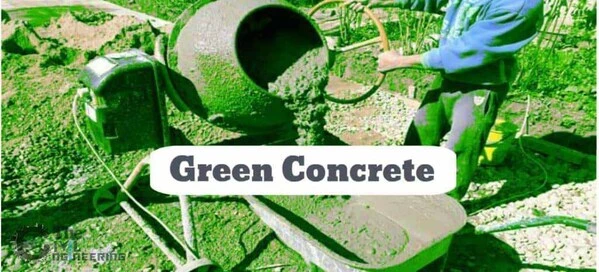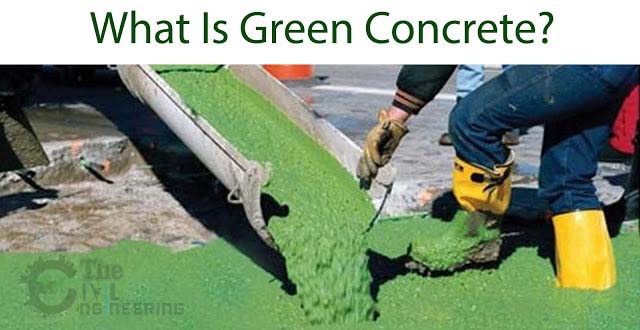What is Green Concrete | Green Concrete Advantages | Green Concrete Disadvantages | Green Concrete Materials | Application of Green Concrete
In this Article today we will talk about the What is Green Concrete | Green Concrete Advantages | Green Concrete Disadvantages | Green Concrete Materials | Application of Green Concrete | Suitability of Green Concrete in Structures | Green Concrete Properties.
In this emerging world, the construction industry is at its peak with magnificent structures. The massive growth in construction industry translates into demand for building materials and concrete is one of the most significant material used in the construction. The major constituents in the production of concrete are cement, sand and aggregates.

As we know every coin has two sides. Development of construction provides the luxurious facilities but also creates an adverse impact on the environment, such as CO2 emission and exploitation of natural materials. Green Concrete Advantages Disadvantages
Let’s understand how it affects the environment.
- CO2 emission: According to ‘Bambang Suhendro (2014) (Published in, Procedia Engineering), 8 to 10 % of the world’s total CO2 emissions comes from manufacturing of cement and 220 kg of coal is being used to manufacturing 1 tonne of cement. The global warming gas (CO2) is released when limestone and clay are crushed and heated to high temperatures. Green Concrete Advantages Disadvantages
- Reduction in naturally occurring materials: Coarse aggregates are excavated from the rock mines and sand from rivers. The rate at which concrete is produced, a significant reduction in these naturally occurring materials is bound to happen.
Since last few decades, our society has become conscious of the deposit problems connected with residual products and demands. Hence government has also imposed taxes and restrictions to control it. However, restrictions are not the solution. The solution lies in finding alternatives which are green and economical. Thus, few alternatives have been explored and “Green Concrete” is one of them.
Green concrete is a recent development in the field of sustainable construction industry. It is a revolutionary concept in the history of concrete technology. Green concrete was first developed by Dr. WG. in Denmark in the year 1998.
OTHER POSTS:
-
Method Statement for Masonry Block Work | Work Procedure
-
Different Types of Doors Used in Building Construction | 37 Types
-
Reinforcement Detailing of RCC Members | Dos and Don’ts
What is Green Concrete ?
Green concrete is an environment centered thinking concept as far as concrete is concerned. It considers every aspect starting from raw materials to its manufacture, concrete mix design and ultimately the structural design, construction, and service life.

It is made with the use of waste material as one of its components. As per ‘Mannan and Ganapathy (2004)’ (Published in, Building and Environment), use of agricultural and industrial wastes as replacement materials in the concrete have dual advantages of a better way of waste disposal and cost reduction. Also, the production process of green concrete doesn’t lead to environmental destruction such as using excessive energy in its production and produces less CO2 than conventional concrete. Hence, the green concrete is also known as eco-friendly concrete or environmentally friendly concrete.
The List of Waste Materials used in the Production of Green Concrete:
01. Substitutes for the Cement:
(a) Industrial Waste:
These materials are the byproducts you can get from the industries like power plants.- Ground Granulated Blast Furnace Slag (GGBS): GGBS is a by-product which can be obtained from the blast-furnaces used to make iron.
- Fly Ash: Fly ash is obtained from the powdered coal burning mostly in power plants.
- Silica Fume: This byproduct is produced during the manufacturing of silicon metal or ferrosilicon alloys.
- Red Mud: Red mud is a by-product which is available during the Bayer’s process of aluminium production.
(b) Agricultural Waste:
Following materials are available as a byproduct of agricultural products.- Rice Husk Ash: Rice husk ash is a byproduct of agricultural waste which is generated in rice mills.
- Coconut Husk Ash: Coconut husk ash is obtained after burning of coconut husk in a controlled environment inside an electrical furnace at 500, 600 and 700 °C.
- Groundnut Shell Ash: This is obtained from the groundnut shell.
- Sugarcane Bagasse Ash: The fibrous residue of sugarcane after crushing and extraction of its juice is recognized as bagasse, and is reused as fuel for heat generation which leaves behind ash which is called sugarcane bagasse ash.
(c) Others:
- Metakaolin: Metakaolin is neither the byproduct nor the entirely natural product. It is produced by the calcinations of pure or refined kaolinite clay at a temperature between 650℃ to 850℃. Application of Green Concrete
02. Substitutes for Aggregates:
(a) Recycled Aggregates:
Recycled aggregates are generated from concrete demolition waste. There are two types of recycled aggregates,- Recycled Concrete Aggregates (RCA): Recycled concrete aggregates contain particles primarily originating from recycled crushed concrete.
- Mixed Recycled Aggregates (MRA): MRA is produced from recycled crushed masonry and includes brick, mortar, concrete, asphalt and gypsum particles etc.
03. Substitutes for Sand:
- Manufactured Sand: Manufactured sand is produced during crushing of stone such as hard granite stone by various crushing equipment like cone crusher, roll crusher etc. It’s a better alternative to river sand for concrete construction.
- Mining and Quarrying Waste: Quarry dust is a byproduct of the crushing process of rock which is an intense material to use as aggregates for concreting purpose, particularly as fine aggregate.
- Surkhi: Surkhi is produced by grinding to powder well-burnt bricks, brick-bats or burnt clay. Application of Green Concrete
- Waste Glass: The waste glasses are collected and crushed to the sand size. It could be used a supplementary material for natural sand as a partial replacement.
- Sawdust: Sawdust are loose particles or wood chippings available as byproduct from sawing of timber into standard usable sizes.
Application of Environmentally Friendly Concrete:
- Green concrete is used in the mass construction projects like bridges, dams, retaining wall etc.
- It is broadly used in building construction.
- It is also used in the road construction.
Advantages of Green Concrete:
Green concrete has many advantages over conventional concrete such as:- Green concrete uses local and recycled materials like fly ash, GGBS (Ground Granulated Blast Furnace Slag, artificial aggregates etc. in the concrete.
- It reduces CO2
- Green concrete reduces environmental pollution.
- It has good thermal resistance and acid resistance.
- Green concrete reduces the consumption of cement overall.
- It is economical compared to ordinary concrete.
- It has better workability than conventional concrete.
- Environmentally friendly concrete helps in the disposal of industrial waste as it uses waste and recycled materials from the industries in the concrete. Like fly ash, rice husk ash etc.
- Green concrete not only helps in recycling of industrial waste, but also solve the disposal problem.
- Green concrete is suitable for mass concreting because the heat of hydration of green concrete is significantly lower than ordinary concrete. This results in a lower temperature rise in mass concreting.
- There is not much difference in the preparation of eco-friendly concrete compared to conventional concrete.
Disadvantages of Green Concrete:
- The green concrete has less split tensile strength than the ordinary concrete.
- In the eco-friendly concrete, the cost of the reinforcement increases with the use of stainless steel.
- A detailed life cycle analysis of green concrete by considering different parameters is must to understand the resultant concrete properties.
- Water (which is again scarce) absorption is high compared to conventional concrete.
Suitability of Green Concrete in Structures:
Several factors which enhances the suitability of green concrete in structures includes:
- Reduce the dead load of the structure and reduce the crane age load; allow handling, lifting flexibility with lighter weight.
- Reduction of emission of CO₂ by 30%.
- Increased concrete industries use of waste products by 20%.
- Good thermal and fire resistance, sound insulation than the traditional concrete.
- Improve damping resistance of the building.
- No environmental pollution and sustainable development.
- It requires less maintenance and repairs.
- Compressive strength behavior of the concrete with water cement ratio is more than that of conventional concrete.
- Flexural strength of the green concrete is almost same as conventional concrete.
To sum up, in the manufacturing of green concrete, waste materials are used as partial or full replacement of natural materials like sand or aggregates. Reuse of such materials gives numerous advantages over conventional concrete, such as, it reduces the extra load on the landfills for waste material disposal. It also contributes to the economy as these materials are cheaper than the original one and charges for the disposal of waste materials are saved. It reduces CO2 emissions and energy consumption which is priceless. Apart from these benefits, the durability of environmentally friendly concrete is also higher in most cases. Hence, it is one of the most essential tools in sustainable development in the future when natural resources will be on the verge of extinction.

